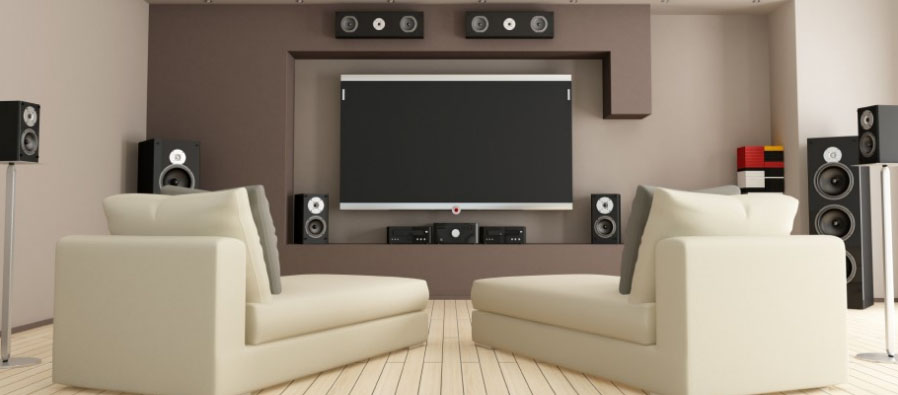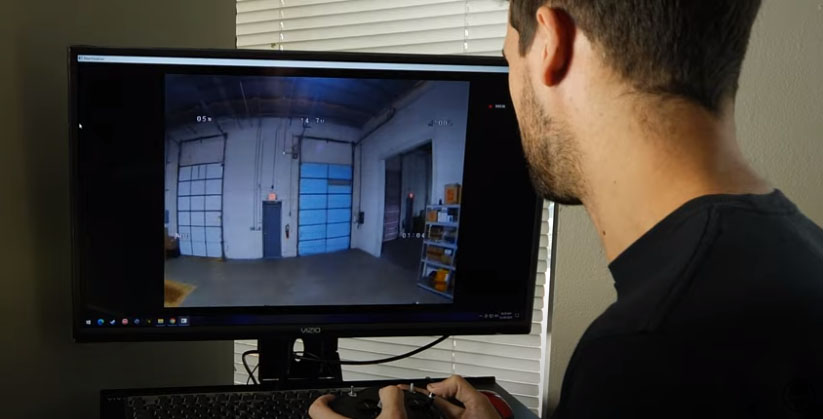- Flat panel TVs have poor audio quality and are moving away from speakers altogether
- Over 3 million soundbars are sold in the U.S. annually
- Wireless surround sound is a better solution for home theater and gaming
- The WiSA standard will disrupt this market in 2019
What's the biggest difference between watching a movie at home versus at the theater? I mean besides the cost of popcorn (crazy, right?). For me, personally, it's the overwhelming feeling you get from the movies. Sometimes, you can almost feel like you're in the action.
That feeling of being immersed in the movie is more than just a function of the big screen. It's the audio that truly surrounds and envelopes you and shakes your seat. With a depth of sounds coming from all angles, true cinema audio can leave you breathless from the experience.
For many people, it's now possible to replicate the "in theater" experience at home. For starters, displays have gotten bigger and better. Meanwhile, the price of video displays has dropped dramatically over the last few years. You can get a large screen TV from Costco at incredibly affordable prices.
Unfortunately, the audio side hasn't kept up with video. Well, that's not completely true. Most movies and even television shows are being broadcast in a surround sound format that enables a great home theater experience. And, speaker quality has improved over the years, even as they have shrunk in size. Thus, it's very possible to pair a surround sound system with a good TV and have a great theater experience.
However, where audio hasn't kept up is in the pricing side. Until recently, it's been virtually impossible to have true surround sound without spending gobs of money on an expensive home audio system. And, if your wife is like mine, spending even more on installing the system as you open up walls to hide the speaker wires that came with every surround sound system. While video has come down in price, audio, due to the cost of wiring a system, just hadn't kept pace. Until now.
The WiSA Standard
The obvious solution to the difficulty and expense of a wired system is to go wireless. If a wireless system existed that supported true surround sound, it would be easy to create a quality home theater environment. One in which the audio quality actually complemented the video, rather than detracting from the experience.
Historically, there have been several issues with creating a wireless surround sound system that have caused this market to remain rather underdeveloped. These issues have primarily centered around latency. No one wants to watch a video in which the lips don't match the words, right? Wireless systems that operate on Bluetooth, or through your homes' WiFi network, typically have issues to lag, leading to an inconsistent end-user experience. This has resulted in a very slow adoption of wireless along with minimal support from major speaker and television manufacturers. Until wireless quality matches that of wired, consumer electronics companies weren't going to manufacture products for that market.
This has all been changing in real time. Around seven years ago, Summit Wireless Inc. (WISA:NASDAQ), a Silicon Valley semiconductor company, developed a standard for transmitting surround sound through a unique WiFi band. What it invented was a system that enabled wireless speakers to receive signals much quicker than any other system. In fact with the amplifiers in the speakers, as opposed to a central stereo, the system has less latency than a wired system. Summit overcame the technical hurdles around wireless transmission.
What Summit did next was the key to changing the home theater market. It took its system and created a standard for wireless immersive surround sound, the WiSA Standard. Instead of trying to build a consumer electronics company around its product, as Sonos has tried to do with wireless speakers, Summit opened WiSA up to everyone, the thinking being if all consumer brands adopt it, the standard will take off. Thus, Summit founded the WiSA Association (more technically, the Wireless Speaker and Audio Association), a standard forming body meant to promote the WiSA standard of wireless immersive sound.
In doing so, Summit is emulating successful standard development models of the past. Think back to two technological breakthroughs, the Sony Betamax and Bluetooth. In the case of Sony, that company developed a videotape system that was proprietary. It was better than VHS and, yet, without broad-based support, it died. Contrast this with Bluetooth, which is a wireless standard. It is open for anyone to license, with current owner of the standard, Qualcomm, getting a royalty on every device. The uniformity of products on the standard enables each and every device to be interoperable; your Bluetooth headset connects with your phone/iPad/PC regardless of manufacturer, right?
The point being that a consumer product companies don't really care what the standard is, they just want a standard to be adopted and become ubiquitous so that they can sell their products to end-users. Meanwhile, consumers want an easy to set up, awesome sounding surround system that will work with any speakers or display. By establishing the WiSA standard, Summit has enabled both consumer electronics companies and consumers.
"Wireless has been disrupting the audio marketplace by providing consumers with incredible access to products that improve the home theater experience and promote high-quality sound while also assuring interoperability. Its revolution has never been louder as it continues its climb with many catalysts helping position it at the frontline of the audio industry. With the wireless audio marketplace expected to be worth $54 billion by 2022, many key factors are contributing to the burgeoning appetite of consumers who demand more convenient, high-performance home theater without the wires." ~ TWICE.COM
Will WiSA Thrive?
In today's consumer electronics market, thinner is better. Flat panel TVs have taken over the market, and they get smaller and lighter by the year. Which is great for looking good on your wall, but is terrible for being able to have quality audio. Great speakers need depth and to be facing the listener to be effective. Yet, the trend is towards smaller speakers, hidden in the display; eventually there will likely be no speaker in displays at all. This creates an audio problem for the consumer.
The natural result of the poor audio in displays is an increase in purchases of external speaker systems for the home entertainment setup. In 2017, the most commonly purchased audio device for home entertainment systems was the soundbar with over 3 million sold in the U.S.
Now soundbars are fine if you're not picky. But, just as television has gone to higher degrees of definition, audio delivered to the home has improved. We have gone from mono to stereo, then to 5.1 surround sound, and now there's even 7.1. Consumers have the opportunity for great sound with their movies, but they need to do more than just purchase a simple soundbar.
When it comes to enhancing your home entertainment's sound system, devices enabled to the WiSA standard are the logical solution. This is for several reasons.
- Wireless is easy to set up, looks better and is much cheaper than wired.
- WiFi standards offer zero latency.
- Higher quality: WiSA transmits at 24bits which is twice that of CD audio.
- And, let's not forget, the sound from true surround is immersive and blows centrally located soundbars away.
WiSA is coming to market now. This past week I purchased a set of Enclave Audio CineHome 5.1 wireless speakers. They are awesome. It took about 20 minutes to set them up and Wham! I had immersive audio.
But, the WiSA standard is still very young. When doing a Google search for the best wireless surround sound systems, the "top 10" list I found included only 5.1 Bluetooth systems or wireless sound bars. As mentioned, both of these have issues, but they are the current leaders in this industry.
This clearly shows that there's an opportunity for WiSA enabled products to take off. But, it will take two things for the WiSA standard to succeed. For WiSA to be a success, there must first be consumer electronics products manufactured to support the standard. For displays, this means devices that offer an audio signal in WiSA format. There also needs to be speaker manufacturers with products designed for the market.
At the same time, consumers need to have access to the products. Ideally, that would be through the larger sellers of consumer electronic devices, such as a Best Buy, Brandsmart, Fry's Electronics, etc. If there is buy-in from both manufacturers and retailers, the WiSA standard has an excellent chance of taking off; as far as I can tell, endorsement from both these groups is very likely as we move into 2019.
Endorsement from the players in the space is picking up as a result of a rather seminal event for WiSA that occurred in 2015 when LG announced that it was going to support the WiSA standard through its membership. More recently LG had a WiSA Ready prototype TV in the WiSA booth at the Consumer Electronics Show in January of this year. Also, Microsoft's Xbox Division demonstrated an Xbox system that was WiSA Ready with an Axiim WiSA USB Transmitter. We look forward to actual products launching in the future. This support from some of the largest consumer brands is spilling over into their competitors. No one wants to be left behind if the standard takes off and you can expect to see more TV manufacturers supporting WiSA soon enough.
The endorsement of LG and Xbox was also enough to start getting speaker manufacturers on board. Trust me when I say none of them wanted Sonos dominating the wireless speaker industry. This group is excited about the WiSA standard and, with TV manufacturers signing up, they are building products for this market. Brands like Harmon, Klipsch and Bang & Olufsen all have WiSA products for sale at this time; the Association is now over 30 members. The WiSA standard is launching in real time.
Gaming could also drive uptake
So far I've only discussed immersive sound in the context of home theaters, but there's another market that has the potential to be equally large, if not bigger. That's the market for gamers. This is a market that is growing rapidly and one in which cutting edge technology is paramount to success.
When you look at the growth in professional gaming leagues and tournaments, and when you consider that every kid (in the U.S. at least) has grown up with video games, it starts to put the potential in context.

The global gaming market is expected to be almost $140 billion in 2018. These are serious people who are investing a lot of time and money into their entertainment. The WiSA standard feeds right into them.
Why is WiSA great for gamers? There are two reasons that would cause a serious gamer to want a WiSA enabled surround system. The first reason is the actual surround aspect of the system. As opposed to a headset, which most gamers wear, a true surround system enables directional sound. In reality, this means a gamer can hear if someone/something is sneaking up behind them. A headset can't provide this ability.
The second benefit comes from the lack of latency in a WiSA system. While you and I might not notice this, it's actually faster than a wired system. Which means sounds reach you sooner. Might be imperceptible to you and I, but to a gamer, it is noticeably different.
These strengths of WiSA over other systems is what led Xbox to join the WiSA forum last year. This is a big deal for WiSA adoption and this Christmas is the first time that products will hit the market that enables Xbox to seamlessly interact with a WiSA system.
Summit Wireless. . .the WiSA standard owner
In order to have WiSA enabled wireless surround sound you need three things. A display that supports the standard, speakers that support the standard and a wireless delivery system that connects the two. This is where Summit Technology comes in.
Summit is to WiSA that Qualcomm is to Bluetooth; for every WiSA system that gets sold, Summit gets paid. Each WiSA 5.1 system requires a wireless transmit module and 6 receiver modules: one receiver per speaker. Thus, with module pricing in the $10-$12 range, a WiSA enabled 5.1 audio system will generate sales to Summit of $70–$80.
The potential market size is big in both home theater and gaming. For home systems, assuming conservatively that 20% of the 3 million people who bought soundbars would have liked an alternative, you can see how Summit could easily get to big sales numbers. Twenty percent market share would be $40–$50 million in revenue to Summit; that's yearly and just in the U.S.
It's not a stretch to see WiSA come to displace soundbars altogether. The major advantage a soundbar has is cost and the price of WiSA enabled systems is dropping. Similar to the way flat panel television prices have come down as volumes pick up, I expect a similar trend on the audio side. The Enclave speakers I just installed are rumored to be coming down towards $500 for the complete system over the next few months.
Meanwhile, a higher end soundbars start at $300 and can be much more expensive at the upper end. It seems to me that the step up in user experience more than justifies the price differential and we could see the soundbar market crash over the next few years.
On top of this is the gaming market, which, by the way, extends far beyond the aforementioned Xbox as more games are sold into the PC market. But, let's just look at Xbox. There were over 59 million Xbox Live users globally in January of this year. These are generally younger adults, very interested in their entertainment and highly likely to not care about dropping $500 on an audio system that can enhance their gaming experience. Remember gamers spent $140 billion on games, don't you think they might spend several billions on the audio for them?
WiSA…Early, but at an Inflection Point
At this point, the WiSA association has been around for seven years. The standard has taken time to catch on with both television makers and speaker companies. But, I think the time is ripe for the proverbial hockey stick in revenue.
I mentioned earlier it will take adoption by consumer electronics manufacturers and retailers to see the standard take off. And, that's a chicken and the egg situation. Without manufacturers, retailers can't sell them. But, without known user demand, manufacturers are loath to commit to production.
LG's support of WiSA is a turning point. So is the success of Sonos. Speaker manufacturers need to compete in wireless and audio retailers need new products to push in their stores. The time is ripe for wireless surround sound and the number of parties interested in seeing it take off is increasing. So is their commitment to the standard.
Christmas of 2018 should mark the beginning of the next phase for WiSA adoption. I expect to see several more name brand television manufacturers support the standard over the next few months. This will drive more speaker companies to offer products and big box retailers to give WiSA shelf space.
Shares in Summit Wireless are the only pure play on this new standard. If WiSA is a hit, Summit will be as well; they are tied at the hip, which is why Summit's ticker symbol is WISA. The company has a clean balance sheet after their recent IPO and plenty of cash to see them through the next 12 months or more. If I'm right about WiSA taking off, those 12 months should be exciting times for Summit.
Daniel Carlson is the founder and managing member of Tailwinds Research Group and its parent company DFC Advisory Services, which is a licensed registered investment advisor (CRD # 297209). Tailwinds is a microcap focused research company that provides research on and consults to over 20 emerging growth companies in the technology and life sciences arenas. DFC Advisory Services is an RIA that manages money dedicated to investing in the companies covered by Tailwinds. For more information on these two companies and their track record, please see www.tailwindsresearch.com. Prior to founding these two entities, Dan spent many years working with small public companies, having been CFO of two public companies and helping finance many others. A 1989 graduate from Tufts University with a degree in Economics, Dan’s formative years in business were spent as an equity trader, first on the Pacific Coast Stock Exchange then on the buyside at several multi-billion dollar firms.
This article was submitted by Tailwinds Research. For more information on Tailwinds Research or on Summit Wireless, please visit www.tailwindsresearch.com.
Tailwinds is engaged by Summit Wireless and owns stock in the company. For a complete list of disclosures, please click here.
[NLINSERT]Disclosure:
1) Daniel Carlson: I, or members of my immediate household or family, own shares of the following companies mentioned in this article: Summit Wireless. I personally am, or members of my immediate household or family are, paid by the following companies mentioned in this article: None. My company has a financial relationship with the following companies referred to in this article: Summit Wireless. Additional disclosures and disclaimers are above. I determined which companies would be included in this article based on my research and understanding of the sector.
2) The following companies mentioned in this article are billboard sponsors of Streetwise Reports: None. Click here for important disclosures about sponsor fees. The information provided above is for informational purposes only and is not a recommendation to buy or sell any security.
3) Statements and opinions expressed are the opinions of the author and not of Streetwise Reports or its officers. The author is wholly responsible for the validity of the statements. The author was not paid by Streetwise Reports for this article. Streetwise Reports was not paid by the author to publish or syndicate this article. Streetwise Reports requires contributing authors to disclose any shareholdings in, or economic relationships with, companies that they write about. Streetwise Reports relies upon the authors to accurately provide this information and Streetwise Reports has no means of verifying its accuracy.
4) This article does not constitute investment advice. Each reader is encouraged to consult with his or her individual financial professional and any action a reader takes as a result of information presented here is his or her own responsibility. By opening this page, each reader accepts and agrees to Streetwise Reports' terms of use and full legal disclaimer. This article is not a solicitation for investment. Streetwise Reports does not render general or specific investment advice and the information on Streetwise Reports should not be considered a recommendation to buy or sell any security. Streetwise Reports does not endorse or recommend the business, products, services or securities of any company mentioned on Streetwise Reports.
5) From time to time, Streetwise Reports LLC and its directors, officers, employees or members of their families, as well as persons interviewed for articles and interviews on the site, may have a long or short position in securities mentioned. Directors, officers, employees or members of their immediate families are prohibited from making purchases and/or sales of those securities in the open market or otherwise from the time of the interview or the decision to write an article, until one week after the publication of the interview or article.




























































